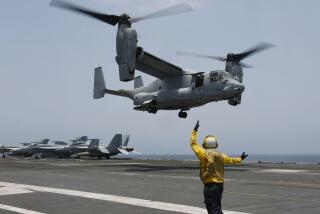7 Believed Dead in V-22 Osprey Crash
- Share via
WASHINGTON — In the second accident in little more than a year, a V-22 Osprey crashed Monday as it approached an airfield at the Marine Corps base at Quantico, Va., where it was to undergo flight tests with Marines aboard.
The accident casts further doubt on the fate of the hybrid aircraft that has been the object of endless wrangling between Congress and the Defense Department.
Marine Corps officials said that the aircraft carried seven people, including several Marines. All were presumed dead. The pilot, who was not identified, was a civilian from the Boeing Helicopter Co.
The Osprey plunged into the Potomac River about half a mile short of the runway in 27 feet of water.
Maj. Barry Moore, public affairs officer at Quantico, said that the Osprey “seemed to be having no problem when it basically dropped right into the Potomac River” early Monday afternoon, apparently as it was shifting its rotors for the transition from horizontal to vertical flight. “The final approach seemed to be error-free,” Moore said. “Something happened at the last second.”
Fishing guide Bill Kramer said that he watched the craft for about five minutes before it crashed. “It headed north about two miles and stalled out and hit the water,” said Kramer.
Kramer, fishing with two clients, said that the Osprey “disintegrated when it hit the water. By the time we got to the wreckage, what was left of the main fuselage had already sunk. It only took minutes for the fuselage to sink. It went down quick. . . .”
Although some witnesses said that an explosion may have ripped through the craft as it raised its rotors so that it could land like a helicopter, Kramer said that “there was no explosion or anything like that.”
One military official who had been to the site said that only tiny pieces of debris were visible. Divers and helicopters were working at the site. Reporters were kept a half-mile away.
Rep. Curt Weldon (R-Pa.), one of the Osprey program’s most ardent backers, said he believes the possibility is “extremely remote” that the crash was caused by a fundamental flaw in design.
“These planes have logged a total of 800 hours of flight testing in 636 separate flights,” Weldon said. The aircraft that crashed Monday had logged 84 flights totaling 96 hours with no problems and no indication of problems with its technology, he added. “It’s done everything it was supposed to do and passed everything with flying colors.”
A spokesman for one of the plane’s two contractors said the cause of the apparent explosion and crash is a mystery. Carl Harris, a spokesman for Bell Helicopter Textron in Ft. Worth, Tex., said that it is “highly premature” to dismiss the plane as technically flawed or politically dead because “we don’t have a clue at this point what caused” the crash.
Defense Secretary Dick Cheney has tried to cancel further development and production of the Osprey, which would ferry as many as 24 Marines from ships to landing sites ashore. But Cheney’s efforts have met with stiff resistance on Capitol Hill, where lawmakers have kept the program alive for more than three years.
The crash of the Osprey comes at a pivotal time in the life of the controversial program. Cheney recently appeared to relent in his campaign to terminate the aircraft when he proposed to lawmakers that the Defense Department open a competition between the tilt-rotor Osprey plane and a conventional helicopter to determine which craft could satisfy the Marines’ needs more cheaply.
While Cheney has argued that the plane is too expensive, he agreed in July to release an estimated $1.5 billion for the Osprey’s development.
The plane that crashed Monday was one of five Osprey prototypes that have been built for testing purposes. It had just completed climatic tests at Eglin Air Force Base, Fla., and was to continue a schedule of emergency escape tests and operational demonstration flights at Quantico, according to Lt. Kim Miller, a Marine spokeswoman. A sixth prototype remains uncompleted as company officials ponder changes in the craft, Harris said.
The Osprey is designed to travel at speeds of more than 300 m.p.h. and as far as 350 miles, but it does not need long runways to take off.
An Osprey crashed in June, 1991, at the New Castle County Airport in Delaware about three minutes into its first flight while it hovered about 15 feet off the ground. No one was hurt.
The crash occurred after the Osprey’s two pilots reported that the aircraft was not handling properly. Investigators later concluded that a manufacturing fault had led to the crash.
More to Read
Sign up for Essential California
The most important California stories and recommendations in your inbox every morning.
You may occasionally receive promotional content from the Los Angeles Times.














